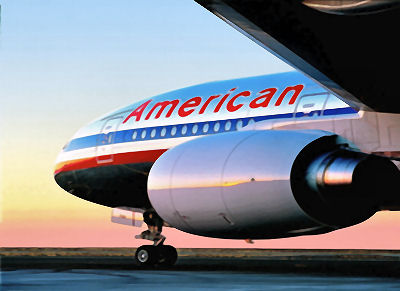Third Quarter 2011 Selected Financial/Operational Metrics For Major US Airlines
October 31, 2011 by Douglas A. McIntyre Net profit/loss
UAL = $773M
DAL = $765M
ALK = $131M
LUV = $122M
LCC = $ 95M
JBLU = $ 38M
AMR = -($162M)
While most of the carriers have recently been reporting consistent quarterly profits, AMR continues their losing streak.
Operating income (more important to look at than net)
UAL = $1,055M
DAL = $1,030M
LUV = $ 247M
LCC = $ 193M
ALK = $ 145M
JBLU = $ 108M
AMR = $ 39M
Both United and Delta have begun taking advantage of their merger related synergies and now have significant -air fare- pricing power that is inherent with the industry consolidation.
Operating “margin”
ALK = 12.1%
DAL = 10.5%
UAL = 10.4%
JBLU = 9.0%
LUV = 5.7%
LCC = 5.6%
AMR = .6%
After accounting for the size of each carrier, Alaska continues to outperform the industry in margins.
Total (absolute) revenue (in millions)
UAL = $10,171
DAL = $ 9,816
AMR = $ 6,376
LUV = $ 4,311
LCC = $ 3,436
ALK = $ 1,198
JBLU = $ 1,195
United and Delta, due to their mergers with Continental and Northwest, have become the big gorillas of the industry. Combined revenues from just United and Continental now total more than the rest of the entire US airline industry (passenger airlines). United’s revenue alone is more than the total of Southwest, US Airways, Alaska, and JetBlue.
Regional/affiliate ratio of total passenger revenue
LCC = 26.0%
DAL = 20.0%
UAL = 19.7%
ALK = 19.4%
AMR = 13.2%
Excluding American, the large network carriers have grown their regional/affiliate networks thereby providing significant O&D revenue and passenger feed to mainline operations.
EBITDAR margin
ALK = 24.1%
JBLU = 16.7%
UAL = 16.0%
DAL = 15.3%
LCC = 12.2%
LUV = 8.4%
AMR = 7.4%
After excluding interest, taxes, depreciation/amortization, and aircraft rents, Alaska is by far, the financially strongest carrier with American being the weakest.
Wage benefit ratio of operating revenue / operating expense (mainline operations)
JBLU = 19.7% / 21.7%
DAL = 21.2% / 24.9%
LCC = 21.9% / 23.6%
UAL = 24.1% / 26.1%
LUV = 26.6% / 28.2%
ALK = 26.8% / 33.2%
AMR = 31.5% / 32.1%
Since 2007 and the upsurge in fuel costs going from approximately 10% of each airline’s operating costs to 30+%, labor has paid the price as most airline labor groups took huge concessions after 911.
Overall labor cost ratio differentials for the airline industry are largely affected by labor contract productivity work rules more so than (current) hourly pay rates.
Pilots from United, Delta, American, and US Airways are currently in contract negotiations and now earn approximately what they were back in the mid 1990’s and -unadjusted– for inflation.
Unit labor costs (wage & benefits cents per mile)(mainline operations)
JBLU = 2.39
LCC = 3.03
DAL = 3.12
LUV = 3.44
UAL = 3.49
ALK = 3.81
AMR = 4.03
While each airline has a unique operation from their competitors, the unit labor cost differential can but not always, play a large part of the overall profit/loss for each carrier. i.e., JetBlue and Alaska are similar size airlines which have the lowest and second highest unit labor costs but are still both profitable.
American’s labor costs consistently rank as the industry’s most expensive in large part because competing carriers were able to shed labor contract work rules via bankruptcy. While American’s hourly wage rates are more-or-less industry competitive, their work rules drive the industry’s lowest productivity.
Mainline system yield (cents/mile) / load factor
ALK = 14.70 / 87.0%
LUV = 14.69 / 82.0%
UAL = 14.56 / 86.1%
DAL = 14.32 / 86.9%
AMR = 14.21 / 84.9%
LCC = 13.76 / 86.5%
JBLU = 13.04 / 84.5%
Yield driven by high(er) load factors provides a significant indicator for an airline’s revenue performance and competitiveness.
Accepting the above, yield is affected by each airline’s “unique” operation. Fundamentals such as domestic/international, long/short haul, premium seating and global alliances all play a role in “yield” performance.
Data excludes ex/special items- Some data may be estimated
DAL = Delta
UAL = United
AMR = American
LCC = US Airways
LUV = Southwest
ALK = Alaska
JBLU = JetBlue
# # # #
Disclosure- The above opinions and comments should not be used to determine the worth of any stock or investment. At the time of writing, the author and his family did not hold stock and/or derivative positions in any of the airlines covered in this article.
_____________________________________________________________
Robert Herbst is an independent airline industry consultant. He is the founder of AirlineFinancials.com which provides airline industry analysis and commentary for major US carriers. In addition to his consulting work, Mr. Herbst was a commercial airline pilot for over 35 years. His aviation experience and financial background provide a unique analytical perspective into the airline industry.
Sponsored: Find a Qualified Financial Advisor
Finding a qualified financial advisor doesn’t have to be hard. SmartAsset’s free tool matches you with up to 3 fiduciary financial advisors in your area in 5 minutes. Each advisor has been vetted by SmartAsset and is held to a fiduciary standard to act in your best interests. If you’re ready to be matched with local advisors that can help you achieve your financial goals, get started now.
